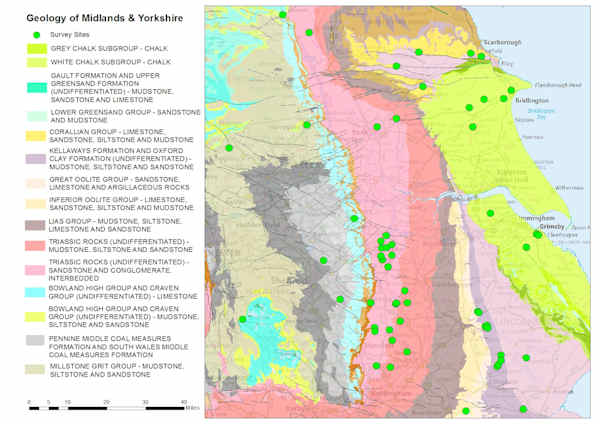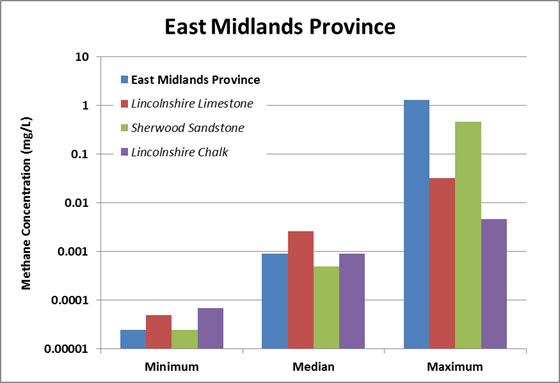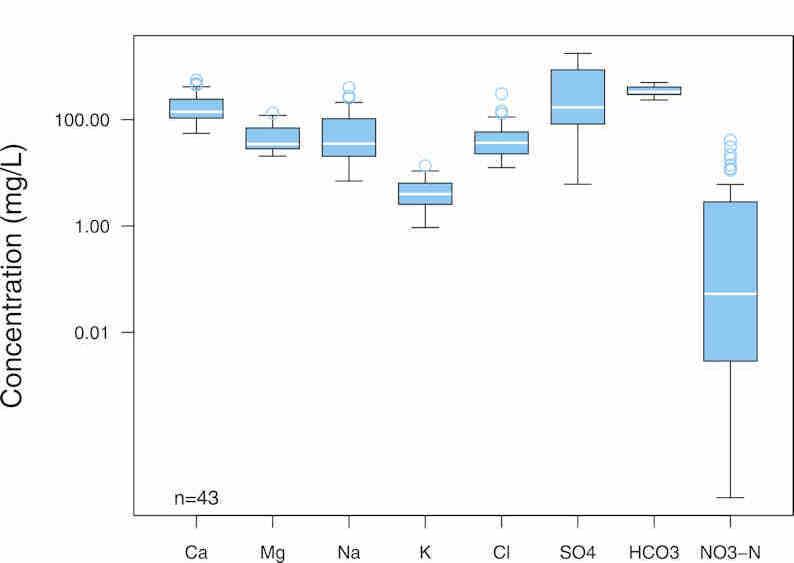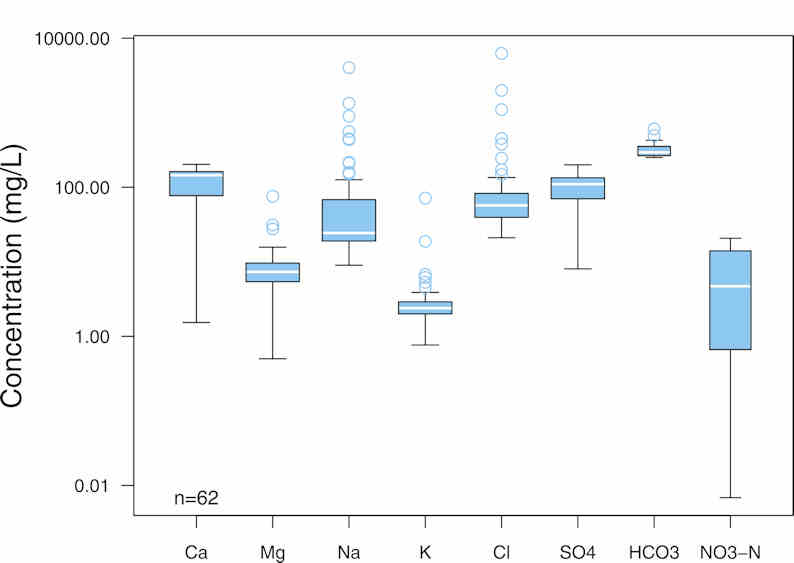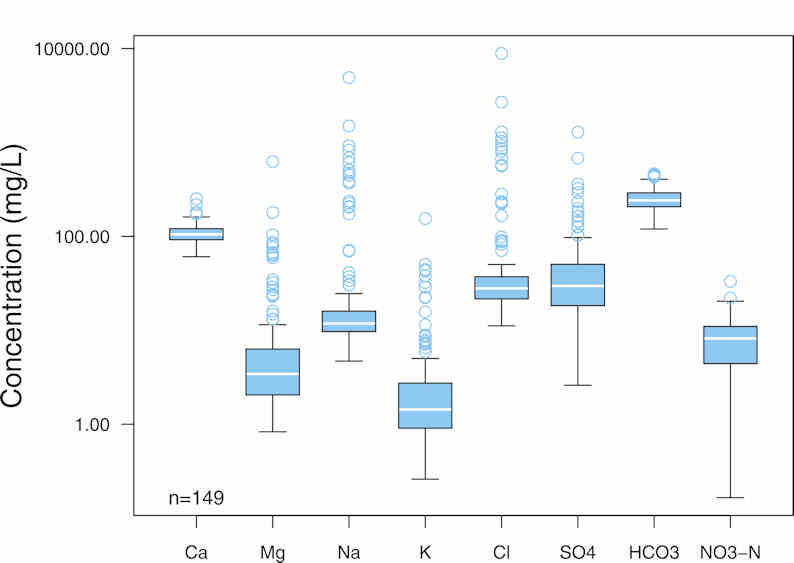East Midlands Province
Regional summary
In the East Midlands Province, 93 sites have been sampled, in the three main aquifers: the Lincolnshire Limestone, Permo-Triassic sandstone and Chalk.
- The Lincolnshire Limestone is a hard, fractured aquifer and groundwater flows almost entirely by fracture flow along bedding planes. Abstraction for public water supply takes place mainly in the confined region, where the groundwater is artesian. It has a maximum thickness of 40 m in south Lincolnshire.
- Permo-Triassic sandstone is the UK's second most important aquifer and has a high porosity, which means the majority of flow occurs through the pore spaces in the rock. The water from this aquifer is generally of good quality and is exploited for a wide range of uses. It has a maximum thickness of 180 m in Yorkshire.
- The Chalk aquifer of Yorkshire and Humberside is a productive fractured aquifer, which outcrops in the Yorkshire Wolds. It has a total thickness of 430 m. A large proportion of public water supply in the region is derived from this aquifer.
There are a number of shale units present in this area, including the Kimmeridge, Ampthill, Lias, Bowland and Craven Groups. The Bowland and Craven Groups are reported to have the potential to form a shale gas resource (Andrews, 2013) in addition to the Kimmeridge Clay, as reported in DECC (2012) 3.7 KB pdf. The Lias, Kellaways, Oxford Clay and Osgodby Formation are thought to be too immature for shale gas.
Methane in UK groundwater results
These summaries are based on the results collected from single visits to each site for the purpose of the methane baseline project. The data are summarised for the Midlands and Yorkshire as a whole, and also for individual aquifers, where enough data are available.
The blue boxes highlight where summary data are available for baseline groundwater quality in the different aquifers present in this region, and link to the summaries for each region.
| Area | Concentration (mg/l) | Number of samples |
||
|---|---|---|---|---|
| Minimum | Median | Maximum | ||
| East Midlands Province | <0.00005 | 0.0009 | 1.32 | 93 |
| Lincolnshire Limestone | 0.00005 | 0.0026 | 0.032 | 13 |
| Sherwood Sandstone | <0.00005 | 0.0005 | 0.465 | 34 |
| Lincolnshire Chalk | 0.00007 | 0.0009 | 0.0047 | 23 |
Baseline groundwater quality data in the Permo-Triassic sandstone
A summary of the baseline quality of groundwater in the Permo-Triassic sandstone is below. These data were collected as part of a collaborative project between BGS and the Environment Agency to investigate the baseline quality of groundwater in major UK aquifers. The UK baseline study results page provides downloads of all the reports produced by the project.
| Analysis | Concentration (mg/l) | Number of samples |
||
|---|---|---|---|---|
| Minimum | Median | Maximum | ||
| Ca | 55.3 | 140 | 556 | 43 |
| Mg | 20.6 | 34.7 | 133 | 43 |
| Na | 7 | 35.3 | 402 | 43 |
| K | <0.6 | 4 | 13.5 | 43 |
| Cl | 12.5 | 36.6 | 307 | 43 |
| SO4 | 6.1 | 170 | 1760 | 43 |
| HCO3 | 234 | 333 | 498 | 43 |
| NO3.N | <0.0025 | 0.053 | 41.1 | 43 |
The quality of groundwater in the Permo-Triassics sandstone is determined by natural reactions between rainwater and the bedrock, which creates a variable baseline. Nitrate (NO3.N) and chloride (Cl) are elevated due to agricultural and industrial practices, and the groundwater can have a higher salinity in the confined part of the aquifer.
Baseline groundwater quality data in the Lincolnshire Limestone
A summary of the baseline quality of groundwater in the Lincolnshire Limestone is below. These data were collected as part of a collaborative project between BGS and the Environment Agency to investigate the baseline quality of groundwater in major UK aquifers. The UK baseline study results page provides downloads of all the reports produced by the project.
| Analysis | Concentration (mg/l) | Number of samples |
||
|---|---|---|---|---|
| Minimum | Median | Maximum | ||
| Ca | 1.53 | 144 | 203 | 62 |
| Mg | 0.5 | 7.3 | 75.5 | 62 |
| Na | 9 | 23.7 | 4030 | 62 |
| K | <1 | 2.37 | 71.5 | 62 |
| Cl | 21 | 57.1 | 6250 | 62 |
| SO4 | <0.2 | 110 | 200 | 62 |
| HCO3 | 251 | 294 | 606 | 23 |
| NO3.N | <0.003 | 4.7 | 20.7 | 37 |
In the Lincolnshire Limestone, the quality of the water varies considerably between the unconfined and confined regions. In the recharge areas, the water is fresh, although impacted by agricultural pollution, whereas the confined groundwaters are old and reducing, and can be of poor quality.
Baseline groundwater quality data in the Chalk
A summary of the baseline quality of groundwater in the Chalk is below. These data were collected as part of a collaborative project between BGS and the Environment Agency to investigate the baseline quality of groundwater in major UK aquifers. The UK baseline study results page provides downloads of all the reports produced by the project.
| Analysis | Concentration (mg/l) | Number of samples |
||
|---|---|---|---|---|
| Minimum | Median | Maximum | ||
| Ca | 60.8 | 105 | 252 | 149 |
| Mg | 0.83 | 3.43 | 626 | 149 |
| Na | 4.7 | 11.8 | 4910 | 149 |
| K | 0.26 | 1.42 | 155 | 148 |
| Cl | 11.2 | 27.9 | 8890 | 149 |
| SO4 | <5 | 29.7 | 1290 | 149 |
| HCO3 | 120 | 241 | 464 | 148 |
| NO3.N | <0.2 | 8.01 | 33.2 | 148 |
The quality of groundwater in the Chalk aquifer of Yorkshire and Humberside is very variable due to a number of geochemical processes. The Chalk groundwater is generally hard and the unconfined areas have been impacted by seawater intrusion and human activities, such as pollution from agriculture. Groundwater in the confined and semi-confined sections of the aquifer has some protection from the effects of pollution.
Contact
Please contact BGS Enquiries for more information.


